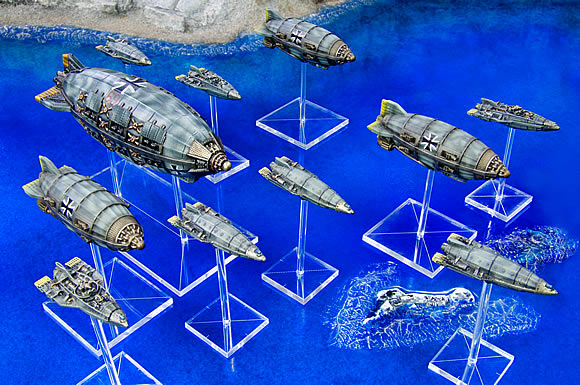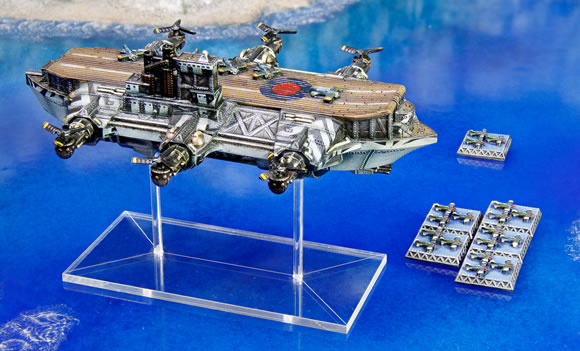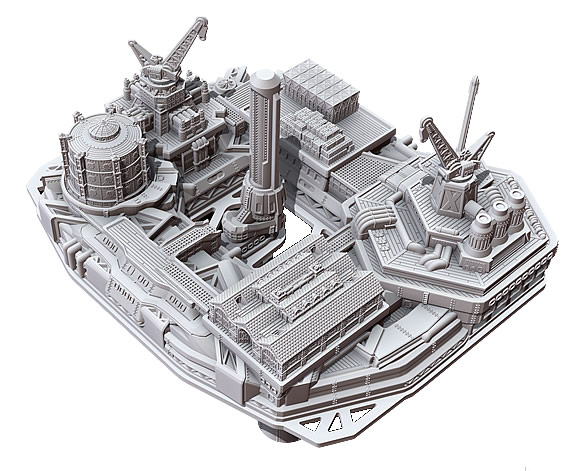
Frontline Despatches 4: Operation Thunderhead
Operation Thunderhead – The Broken Fist
A Dystopian Wars narrative by Spartan Franco
The stalwart Commodore von Bayer had performed sterling service in holding his battered naval fleet together, but it was a sorry collection of warships that limped back into Conradsburg harbour through the Mozambique Straits.
The Crushing Fist flotilla survivors would take many weeks to recuperate, leaving Admiral von Grundwald lacking much of his offensive power. The fiery Austrian commander seethed while the Britannians arrogantly continued building their West African stronghold.
But while her naval peer salved his injured pride by continuing to expand Conradsburg, Air Marshal Ursula Lindemann, commander of the 57th Superiority Air Fleet, planned her own offensive against the Britannians.
Ursula had been posted by Military Sire Prince von Tannhauser himself. Formerly a crack pilot, she had proven a talented strategist and quickly ascending through the ranks of the officer corps; gaining a reputation for well-planned shock attacks honed on the Carpathian Front.
She had tried – and failed – to convince Grundwald to delay his own naval offensive while her own forces built up to strength. The aerial journey from Imperial airspace was challenging; with her force just as badly affected by the unnatural weather as the warships on their oceanic travel.
Now her command was fully operational, able to launch its own attack. Intelligence reports indicated that enemy airborne strength was limited. The Britannian Aerial Armada was still its smallest major command in the area, and its resources stretched far too thinly. Her forces were much more evenly matched for the upcoming battle.
Gathering the Thunderhead
Even as the Crushing Fist sailed for its fateful confrontation off Angra Pequena, Lindemann patiently assembled her aerial taskforce; drawing from the steady stream of aerial reinforcements arriving at Conradsburg and alighting upon its landing fields and sea-pontoons.
By the time the naval flotilla was sailing home from its drubbing, her 4th Aerial Strike Fleet was ready for action. At its heart was the mighty Imperium Class Sky Fortress Herzog Emil von Wittgenstein. Accompanying it would be two Gewittewolke Class battle Zeppelins – HZ55 Graf Rudolf and HZ59 Kugelblitz. Half a dozen lighter Pflicht type light Zeppelins formed the fighting backbone of the force, with several Jager type strike ships for aerial defence.
But the Zeppelin fleet formed only half of Lindemann’s forces and strategy, the ‘thunder of the storm’. The other half, the ‘lightning’, consisted of several wings of Geier and Adler bombers, almost half the 57th’s available heavy attack aeroplanes.
The bomber crews’ role was vital; Thunderhead’s targets were a cluster of the mysterious Britannian seaborne structures identified by the intrepid aerial and naval scouts of Crushing Fist.
The bombers would be tasked with first hammering the inevitable enemy flak batteries, and then marking the targets with deadly Speer lightning rods. Since Lindemann expected them to be flying into the teeth of heavy defences, the bombers were well escorted by crack fighter wings.
However, aside from the Wittgenstein’s own air wings, Thunderhead would have no dive bombers or torpedo carrier available. The smaller aeroplanes would need to carry additional fuel. Only fighters, unencumbered by ordnance, could manage this mission. The attack on the platforms themselves would fall to the Zeppelins.
When Commodore von Bayer’s clarion communique reached the radio operators of Conradsburg, he could hardly have wished for a better force to carry the vengeance of the Prussian Empire to the enemy!
Storm on the Horizon
Lindemann herself decided to lead the mission in person, leaving command of the 57th in the hands of her capable deputy, Air Vice-Marshal Heinrich von Sickingen.
As repair crews swarmed over damaged Imperial warships, the air over Conradsburg reverberated with the ominous bass droning of aerofans as the huge Zeppelins of Thunderhead untethered and rose from their docking masts. The massive craft formed up into a diamond formation and began their journey west.
Conscious of the relative speeds of her forces, Lindemann had elected to give her Zeppelins a twenty-four-hour head start. She had estimated a journey time of seventy-two hours for the airships, allowing for the weather and synchronising speeds with the slowest craft.
While the Zeppelin fleet would sail more or less as the crow flew towards their targets, Lindemann elected to send her conventional aircraft in an arc to the south west. She intended for them to sweep down on the target structures from the south in the first strike, sowing further confusion ahead of her own arrival from the east.
As with their naval counterparts, Lindemann’s forces ran into unpleasant weather as they travelled across southern Africa, but they had greater luck than von Bayer. Although the sturdy Zeppelins were buffeted by spiteful winds, they did not encounter any truly savage storms.
Guardians of the African Shores
Lindemann’s information about the state of the Britannian air defences was mostly accurate. With most of their forces protecting Batonga, the more distant southern platform cluster, closer to Pequena, relied mostly on fixed defences for security.
Air-Commodore Graham McTavish was keenly aware of this shortfall. His flagship, the powerful illustrious Class Sky Fortress Suzerain was a strong asset, as was the battle-hardened War Rotor Dragon of Albion, but he only had four Hawk scout rotors at his disposal.
His command was, however, blessed with several squadrons of sleek Merlin interceptors, freshly arrived from Britannia itself, and supporting wings of conventional fighting ‘crates’, based at airfields only a few minutes’ flight time away.
Nonetheless, the cautious McTavish knew his command must depend on the heavy flak defences to bolster their strength. Unwilling to disperse his command, especially his prized Hawks on recce missions, he opted to await the coming storm in familiar airspace; providing point defence for the precious Sturginium Drilling Rigs rising from the seas.
Lighting Strike!
It was as well that McTavish kept his forces close to hand; the storm that boiled up out of the southern skies from the direction of Pequena was not the work of natural forces.
The first wave of Prussian heavy bombers came in low, terrifyingly so for such huge aircraft. The deadly Geiers, stalwarts of Imperial aerial attacks since the start of the World War, hammered at the defensive batteries shielding the massive platforms.
Crackling lightning strikes lashed out, shattering wood and stone from their terrible impacts, and cutting down exposed Britannian sailors and artillerists where they stood. The defence towers shook from the impact of multiple payloads of bombs, explosions intercut with yet more lightning from short-lived Tesla pulse emitters.
But the Britannians would not give up without a fight. Multiple batteries of heavy Nordenfelt machine-cannons put up a storm of fire and shrapnel. Black clouds of ‘Archie’ burst amid the attacking bombers, sending several spiralling into the waves as burning, shattered wrecks.
As the flak towers were battered, the second wave of bombers roared in, the Adlers, heading for the mighty drilling platforms themselves. If anything, they met even heavier resistance. Waves of Britannian biplanes rose like swarms of hornets, engaging the long range Prussian Aviatiks with lethal fury.
The bombers themselves were met with roaring Merlin interceptors slashing at them with heavy-calibre automatic cannon. As they drew closer, a veritable volcano of ack-ack fire erupted to meet them; box-barrages turning entire swathes of the sky into maelstroms of smoke and razor-sharp, airframe-shredding shrapnel.
Despite the fury of the defence, and the loss of several aircraft to the savage Britannian firestorm, the bomber crews remained true to their tasks. Deafening hisses echoed as their Speerschleuder batteries let fly. The deadly missiles hammered into the closest drilling rig, setting off yet more waves of electrical fury across its massive bulk.
But the insidious effect of the impacts would only reveal their truly devastating consequences as the mighty Prussian Zeppelins, the thunderous second wave of Lindemann’s attack, approached like the fall of doom!
Descent of Thunder
Above the duelling bombers and fighters, the battle reached literally new heights of devastation as Lindemann’s Zeppelin fleet arrived on the scene. MacTavish, knowing his forces were overmatched, nonetheless signalled the attack.
The thumping of the Britannian rotors as they rose to meet the foe made a sharp counterpoint to the dread droning of the Prussian aerofans. The mighty Kugelblitz, in the Prussian van, immediately engaged the Dragon of Albion.
Lighting played across the huge War Rotor’s vulnerable upperworks at it tried to match the enemy’s altitude. Unable to elevate its main battery high enough to engage the looming Gewittewolke, it nonetheless managed to punch one of Thunderhead’s Pflichts out of the sky with a deadly accurate salvo of shellfire.
But before it could reload, its deck crews and marines suddenly found themselves engaged in a fierce struggle with swarms of aerial Luftlancers descending from the Kugelblitz like living lighting strikes.
Lindemann drove her force in a straight run for the southernmost of the storm-lashed rigs. To McTavish’s mounting dismay, he realised that he didn’t have enough firepower to stop their advance. Though lashed with gunfire of every calibre, the Zeppelins absorbed huge punishment and kept coming. The Wittgenstein and Graf Rudolf overflew the embattled drilling rigs almost side by side.
Even as the guns of the Illustrious and a storm of flak from the installations exploded around them, a mighty tempest of terrifying strength burst from the airships’ multiple energised Tesla coils. Ravening lightning bolts tore through a platform, their devastation made all more intense by the many pulsing electrical spearshots lodged all over its structure.
A great stream of green flame erupted from the massive rig as its central drill-shafts gave way. The rocketing inferno missed the Wittgenstein by less than two hundred feet, but to Lindemann’s horror, the Rudolf was struck hard. The flaring Sturginium scorched several huge rents in its port side. Venting flames, it began to bank, still airborne, but only just.
With the Britannian defences forming up, and one target heavily damaged if not wrecked, Lindemann decided to abort her attack. Shielding the crippled Gewittewolke with her Imperium’s Tesla batteries, she swung her airship force east and began to withdraw at speed.
McTavish ordered his interceptors to harass the retreating Prussians while he tried to reform the rest of his forces. He had little choice in the matter. The Dragon of Albion, though still airborne, had been all but crippled by the fierce Prussian assault and two of his Hawks lay ditched in the sea near the burning rig.
Zeppelin Kaput!
Although the surviving Prussian bomber aircraft were easily able to outdistance the Kingdom’s heavier aeroplanes, the slower airships of Lindemann’s command were subjected to no less than half a dozen strikes as they rumbled through the southern African skies towards Conradsburg and safety.
It was over the Kokinga Mountains that disaster finally struck. The Rudolf, which had been sinking ever lower in the sky for several hours, was strafed by three Merlins that had managed to fight their way past the Wittgenstein’s fighter patrols.
On the bridge of the Imperium, Lindemann blanched as she watched the great Zeppelin’s terminal descent into the wild Kokingas. It was not just the loss of the airship and many of its crew, but also that of the craft’s cargo – and passengers. She could only hope they had survived…
As the fleet rumbled onwards for home, the Wittgenstein broadcast Lindemann’s urgent signal over and over: “Zeppelin Kaput! Package Lost! Urgent Recovery Required. Repeat, Zeppelin Kaput!”
In our next Frontline Observer you can emulate the brave actions of the flyers we detailed above by playing our Operation Thunderhead Scenario which we will present for use with the Dystopian Wars 2.0 rules and also for Dystopian: Fleet Action.
Knowledge is Power!
A Dystopian Legions scenario by Spartan Giles
Following on from our Swiss Times adventures, Spartan Giles has created a scenario for Dystopian Legions which pits two opposing Assault Parties against each other. Tasked with finding top secret documents, the mission is fast and furious! Download the scenario here.




